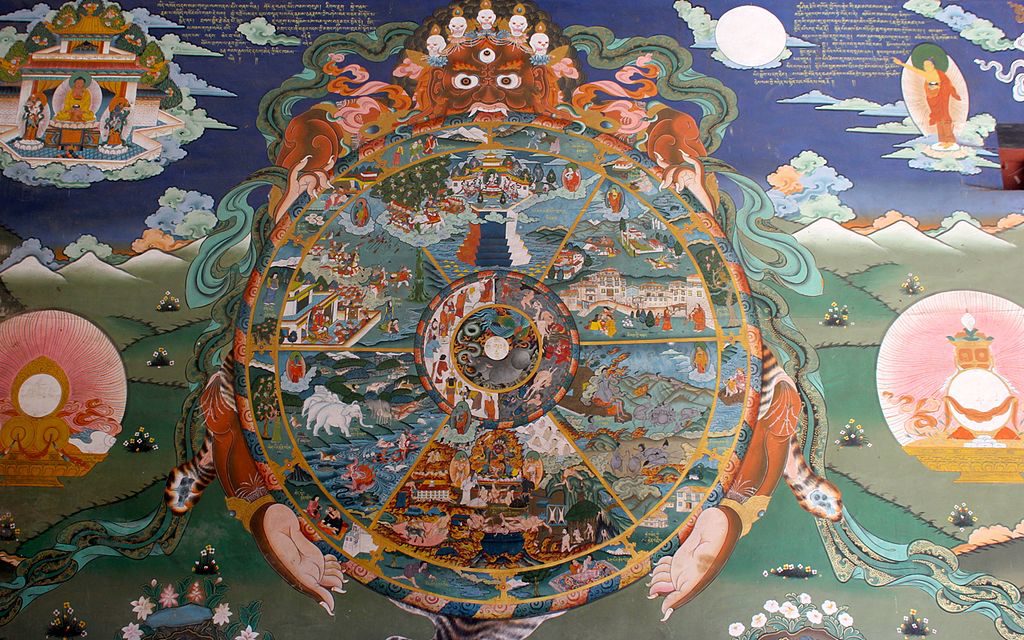[This is a talk more or less as I gave it at the Brooklyn Society for Ethical Culture on October 23, 2016. It is based on a chapter in Rethinking Religion: Finding a Place for Religion in a Modern, Tolerant, Progressive, Peaceful and Science-affirming World.]
Hello. I’m so pleased to be here today. Many years ago I lived in New Jersey. And in those days I often attended lectures hosted by the Ethical Culture Society in Teaneck. So I come here with an appreciation of what you’re about.
I have been a formal student of Zen Buddhism for nearly 30 years. Zen is my spiritual path. However, let me assure you I’m not here to sell you on Buddhism, but simply to offer a perspective adapted from Buddhism for your consideration. I’m calling it “practical Zen” because I intend to avoid the enigmatic one-hand-clapping stuff and keep this talk grounded in our common experience.
Let’s begin with a quote from a Chinese text that is not Zen, but Daoist. This is paraphrased somewhat from the Dao Dejing, verse 18 in most translations. This passage describes a series of fallback positions.
When the Dao is lost, we fall back on virtue.
When virtue is lost, we fall back on humanity.
When humanity is lost, we fall back on morality.
When morality is lost, we fall back on religion.
If I could provide an executive summary of this talk, it would be that to move toward a more ethical culture we need to climb back up this ladder, at least to virtue. And if you want to go for broke and aim for the Dao, great.
So let’s talk about how we might do this.
There’s a basic Buddhist teaching that says what we might call psychological impulses, including our emotions and thoughts, are the forerunner of all actions. One aspect of that is that the way we conceptualize the world around us conditions how we relate to the world. So the first step in considering a moral course is to look very closely at how we conceptualize morality.
I looked “morality” up in an English dictionary and found “principles concerning the distinction between right and wrong or good and bad behavior.” Another definition says morality is “beliefs about what is right behavior and what is wrong behavior.”
But the fact is, we don’t agree about what’s right and wrong or good and bad behavior. Especially as our communities and nations become more diverse, we more and more often are butting heads with people who have entirely different beliefs about what right and wrong, good and evil even mean.
Where do these beliefs come from? I never heard of people putting them to a vote. Some of us are stuck in the idea that morality is about following absolute rules that are eternal and unchanging because God said so, even if those rules are making everyone miserable. And to an increasing degree, that rigidity is tearing us apart.

Is there another way to define morality? The Sanskrit word found in early Buddhist scriptures that is translated into English as morality or ethics is sila. Sila has a connotation of harmony; it’s acting in a way that allows people to live in harmonious families and communities. Sila involves cultivating an atmosphere of trust, respect, and security. Rules can be useful to help with that cultivation, but by themselves they are not the be-all and end-all of morality.
Buddhism does have moral rules, of course. Monks and nuns have hundreds of rules. Laypeople have five. We call them Precepts. The Precepts for laypeople are very basic ― don’t take life; don’t take what is not given, don’t misuse sexuality, don’t deceive others, avoid intoxicants. Those are the five Precepts every school agrees on; Zen throws in a few more. The Precepts are something like training wheels. We practice the Precepts in order to cultivate morality, humanity, virtue, compassion, kindness, and all that stuff, which is where true morality originates.
There’s an American Zen master who is also a Unitarian Universalist minister named James Ford. James Ford wrote about the Precepts recently,
“Frankly, there are times we just need the rules. Much of our lives we’re wandering around in the thickets. Haven’t a clue. We’re lost. And the precepts can become a life line thrown out to us. Sometimes we just have to grab that line. Sometimes we just have to follow the rules. …
… But if we live only in the realm of rules we are strangled by dead letters. And not only are our own lives constrained, we become caricatures of our true potentiality.”
Some rules really are necessary. Rules about theft and homicide, for example. Without some rules, we humans would never have left the caves. We’d still be huddled around our little fires, guarding our flint arrowheads from those people in that other cave. Civilization wouldn’t be possible.
But we’re still left with a lot of rules that seem to serve no useful purpose. We’re fighting over who can use which public restrooms, for example, because of some people’s rigid ideas about morality. We’re fighting about reproductive rights, about who can get married, and who has to bake wedding cakes.
What’s the point? What does denying people the right to follow their hearts, or in the case of the restroom issue, their bladders, have to do with cultivating an atmosphere of trust, respect and security? In this case, rigid rule-following is having the opposite effect.
Another way to understand the religiosity-morality connection is explained in a book I bet some of you have read, which is The Righteous Mind, by Jonathan Haidt. Haidt provides a rigorously tested argument that we feel before we judge. The moment we are confronted with a moral question, something in our subconscious or intuitive mind churns up feelings about the question that determine our position. Our rational mind then constructs a narrative that explains to us what we think and why we think it. This happens so quickly we usually aren’t aware that’s what we’re doing.
Haidt’s explanation of how we respond to moral questions is very similar to what many Buddhist philosophers have taught for centuries, so it’s good to see science catching up.
Anyway, according to Haidt’s hypothesis, as much as we all want to think we are rational and logical and think the way we do for serious reasons, the fact is that we all allow rudimentary emotions to dictate what we think, at least about some things.
When you understand that much of “morality” is about rudimentary emotions and biases, you might also understand why conservative and dogmatic religions of all persuasion tend to get hung up on sex and on keeping women under control. This tells me that the men in charge of things are channeling their own anxieties about sex and women and projecting them into their scriptures. In doing so, they sometimes wander quite a distance from what their scriptures actually say, revealing how pathologically deep those anxieties are. And because they have the authority of institutional religion behind them, these men are given great moral authority in our culture. But in truth, often what we’re seeing from religious authorities is plain old bigotry. And religion is just being used as an excuse for it.
I feel strongly that one of the many steps we need to take to restore some sanity to this fractured nation is to de-authorize religious authorities from dictating morality to all of us. As a diverse society, we require a secular basis for our common ethics.
While we’re on the subject of thought and actions, I want to talk about good and evil. The way we conceptualize good and evil has real-world consequences.
For example, on September 14, 2001, President George W. Bush said this at a prayer service at the National Cathedral:
“Just three days removed from these events, Americans do not yet have the distance of history. But our responsibility to history is already clear: to answer these attacks and rid the world of evil.”
Rid the world of evil? That really should have set off a lot more alarm bells than it did.
Here’s another quote: In a New York Times column published February 11, 2004, David Brooks wrote, “Some liberals have trouble grasping evil, and always think that if we could take care of the handguns or the weapons of mass destruction, our problems would be ameliorated. But I know the problem lies in the souls of our enemies.”
Now, what might we infer about “evil” from these quotations? The first suggests that “evil” is something tangible, with some sort of finite mass and material substance, and if we just work hard enough we can whittle ‘er down and be done with it.
The second suggests that evil is a quality or attribute that some people possess, and others don’t. And once evil has infected “the souls of our enemies” there is nothing to be done but to eliminate them.
Of course, it’s likely “our enemies” feel exactly the same way about us.
People are seduced into evil because they don’t recognize evil as evil. They mistake it for justice, or righteousness, or even God’s Will. And the seduction begins with the thought that “I’m a good person,” and “his hatred of me is evil, but my hatred of him is justified.” As soon as we identify ourselves as “good” and the Other, whoever they are, as “evil,” we’ve well on the way to giving ourselves a cosmic permission slip to do whatever we want to be rid of them. You see the problem.
I say this seductive impulse is at the root of most of the mass atrocities humankind has inflicted on itself through the ages. That’s why the way we conceptualize good and evil has real-world consequences.
Please understand that I’m not saying people or nations shouldn’t defend themselves from those who intend to do them harm. What gets us into trouble is thinking that we’re entitled to Holy Retribution, or that we are somehow qualified to pass judgments and inflict brutality on entire populations, because we’re the good guys.
I used to run into the words good and evil in Buddhist sutras, and these words often nagged at me as being out of place. So I had something of a breakthrough when I found out that the Sanskrit or Pali words being translated as good and evil actually mean “skillful” and “unskillful.”
I’ll give you a mindfulness exercise. Very Zen. Sometime, either now or while you’re sitting in a quiet place, think the word “evil.” Don’t contemplate what it means, just hold the word in your consciousness. And as you do that, pay close attention to the subtle emotional cues within your body that are triggered by the word “evil.”
Now, think the word “unskillful.” If you are tuned in to yourself, you might notice a different reaction. It’s very subtle, but it’s real.
At the very least, maybe we’d be less likely to bomb people for being unskillful.
Zen teachers say it’s important to appreciate that “evil” really has no substance and no independent existence. It is no-thing. It does not infect people. Evil “exists” only in intentions, actions and consequences.
If we understand that neither we nor our enemies are intrinsically good or evil, does that change how we see traumatic events? Speaking as an eyewitness, as I’m sure some of you are, the collapse of the World Trade Center towers easily was the most terrible thing I ever saw, but I honestly don’t see why hanging the label “evil” on it makes any difference. It was what it was. But my perspective enrages some people who clearly think it is vitally important to label the event as “evil,” and if we don’t we’re somehow being soft or letting the terrorists win.
There’s some kind of magical thinking lurking around in there, somewhere.
I don’t agree entirely with the postmodernist view that good and evil are purely relative or matters of subjective judgment. Skillful or unskillful are not just relative. Causing harm to another is unskillful. Wasting natural resources or adding to global climate change are unskillful, even if they aren’t covered by the Ten Commandments. That’s the problem with moral rules left over from the Bronze Age; we’ve got different problems now.
And then there’s “moral clarity.” In the U.S. many religious conservatives place great value in “moral clarity,” which I define as a state of mind achieved by staking a fixed position on a presumed moral high ground and then ignoring the details of human life that fog the view.
For example, I have read many essays arguing for criminalizing abortion that go on and on about the humanity of the fetus without mentioning the pregnant woman at all. If she is mentioned, she is considered to be a kind of niggling technicality. Or worse, she is portrayed as weak-minded or otherwise unqualified to make her own moral decisions.
The “moral clarity” crowd must never admit that the woman is a valuable and intelligent human being who may be in a terribly difficult situation, because empathy and compassion for her would block their “clarity.”
In short, moral absolutism requires ignoring genuine human life experience. This makes its rigid application anti-human and oppressive.
I want to cite the late Robert Aitken Roshi, who was one of the most revered patriarchs of American Zen. In his book The Mind of Clover: Essays in Zen Buddhist Ethics, he said, “The absolute position, when isolated, omits human details completely. Doctrines, including Buddhism, are meant to be used. Beware of them taking life of their own, for then they use us.”
Does moral absolutism even work? There is data showing us that rates of divorce and out-of-wedlock pregnancy are higher in conservative “Bible Belt” U.S. states than in more liberal ones, and this pattern seems to replicate itself worldwide.
Reasonable people may disagree about whether abortion is immoral, but note that rates of abortion in overwhelmingly Catholic Latin America, where abortion is nearly everywhere illegal and harshly punished, are higher than in the United States and a lot higher than in mostly liberal and allegedly decadent western Europe.
And what does his tell us? It appears that when absolutist morality is enforced, either by public shaming or by law, actual human behavior — heterosexual behavior included — is driven into the closet, leaving actual humans with no practical guidance in their actual circumstances.
I say the absolutist approach to morality gets everything backward. It creates too wide a gap between public righteousness and what people are really doing in their private lives, so that the moral rules are not really guiding anyone. And when we cede the presumed moral high ground to the absolutists, too often we squelch open and honest discussion of our real-world circumstances and behaviors.
Again, “The absolute position, when isolated, omits human details completely. Doctrines are meant to be used. Beware of them taking life of their own, for then they use us.”
Secular moralists sometimes propose a utilitarian or consequentialist approach to morality. Very broadly, utilitarianism is the view that the morally right action is the action that produces the most good. There are many variations of utilitarianism, however, mostly because people disagree on what constitutes “good.” Further, this approach often fails to provide an incentive for “being good.”
Author and neuroscientist Sam Harris has proposed that science can provide a basis for morality. Harris is a smart guy and he says many things worthy of consideration. But he’s written that science can “tell us what’s objectively true about morality” and “give us answers about right and wrong.” I think that’s right up there with thinking we can rid the world of evil.
I have a more radical proposal here. Some things people need to work out for themselves.
Human life is infinitely complicated and messy, and circumstances have a way of confounding application of one-size-fits-all solutions. Some things people need to work out for themselves. And that’s okay.
I propose that given the infinity of variables, no two human beings ever faced completely identical moral dilemmas. When faced with questions about ending a pregnancy, or a marriage, or when to discontinue life support, or whether to intervene in a friend’s problems or let things sort themselves out — we need to be able to apply some subjectivity to matters that will change our lives and the lives of those around us, because we’re the only ones familiar with most of the variables.
We’re the only ones who have our medical history, or our parents, or our financial or physical resources, or our marriage, or our job, or our special needs child. Etc., etc. I think that in some circumstances we need the freedom to be subjective, to consider complex moral questions not just in the abstract but in the light of our particular life and situation.
The challenge to us as a society is to distinguish between those behaviors that cannot be allowed ― such as homicide ― because allowing them would damage civilization; and those problems that people need to work out for themselves, even if we don’t all personally approve of all the solutions. And then we have to persuade the absolutists to back off.
We can, as a society, draw parameters around moral questions — medical guidelines determining when life support is futile, for example. And I agree that science can help with much of that. And then we’ll continue to do what we’ve always done, which is argue among ourselves about where the parameters should be drawn. Maybe arguing with each other is the price we pay for freedom.
If all this sounds terribly ambiguous — yeah, mostly, it is. That’s because you and the world and human life generally are very complicated, and where there is complication, there is ambiguity.
I realize people often are uncomfortable with ambiguity. They want clear rules and sharply defined boundaries. They want all phenomena to be properly sorted into their socially acceptable conceptual boxes. That’s why some people prize moral absolutism. That’s a mostly workable strategy for getting through life, but it’s not real. It’s an artificial order superimposed on the messiness of reality. And sometimes failing to accept reality causes more trouble than it solves.
One of the great humanistic philosophers of the 20th century, Erich Fromm, wrote that people often escape into authoritarian mass movements because they fear freedom. A lot of that fear of freedom is a fear of ambiguity, a lack of clear, bright lines that make your choices for you.
I think we see a lot of that fear in America today. And notice that some of the same people who talk about how they want to protect their freedom seem hell bent on destroying everybody’s freedom to do that. It’s like they’re protecting their freedom to be not free. But those clear, bright lines are not likely to come back, so this is a situation we’re going to have to deal with for a while.
Just about any psychologist will tell you that you can’t force other people to change. We can only look to ourselves. How do we find our own moral compass in the messiness of life?
And to answer this question I want to wade a little more deeply into Zen.
Here’s a question for you. “Can you identify yourself without reference to a relationship?” This is a question I first heard in a sociology class. I’ve never heard anyone provide an answer; I don’t think it’s answerable. It’s something of a koan, because if you work with it you end up exploring the paradoxical nature of the self, which is a very Zen thing to do.
Many schools of Buddhism, including Zen, have a doctrine called the two truths. The two truths describe what seems to be a paradox. On one hand, we are all precious and unique individuals, worthy of respect and compassion.
But at the same time, we take our very uniqueness, our identities, from our relationships. From our roles in our families, from our professions, from the interests we share with others, from the arts and intellectual pursuits we enjoy, with our circle of associations. We are who we are because everyone else is who they are. We are not the entirely self-contained, stand-alone people units we think we are.
This interdependence extends to our biological existence as well. We depend on other life forms to sustain our lives and to maintain the conditions on this planet that make life possible. All beings are interdependent. All beings inter-exist. This comes directly from the teaching of the Buddha.
A metaphor used to help resolve this paradox is attributed to a Chinese master named Dushun who was born in the 6th century. This is called “Indra’s Net.” Imagine a vast net that stretches infinitely in all directions. In each “eye” of the net is a single brilliant, perfect jewel. Each jewel also reflects every other jewel, infinite in number, and each of the reflected images of the jewels bears the image of all the other jewels — infinity to infinity. Whatever affects one jewel affects all of them.
This means every jewel matters. Every person matters. You matter. And everything you do affects everyone else. This is the most essential thing to understand. Everything you feel and think, everything you do or say affects yourself and everyone else. Most effects may be extremely subtle, but they’re still effects. And sometimes even subtle effects can have big real-world consequences.
And at its most basic, an ethical life is a life that produces beneficial effects.
Now, it may seem inconsistent to say that we need to be allowed some subjectivity in our moral choices, while at the same time everything we do impacts everyone else. So let’s take this to another level.
Twenty-five centuries ago, the Buddha emphasized purifying oneself of what he called afflictions or defilements. The chief afflictions are greed, hate and ignorance. This ignorance is ignorance of the inter-existence of all beings, because most of our problems come from thinking of ourselves as separated from everything else. We think that whatever is within our skin is “me” and what’s outside our skin is “everything else.” It’s this misperception that is the chief source of our fear, our greed, our anger, our hatred.
You can follow moral rules to the letter, but if you are harboring greed, hate, and ignorance, you are not living a beneficial life. You are not living an ethical life. You are not cultivating an atmosphere of trust, respect, and security.
The Buddha taught many practices, including meditation and mindfulness, to reduce our afflictions.
There’s nothing magical or supernatural going on here; it’s all about becoming more intimate with yourself. You become more aware of what jerks you around and pulls you out of harmony. You learn to let those things go. If you don’t have some sort of meditation or mindfulness practice already, I encourage you to look into one.
Finally he encouraged us to develop four particular virtues above all others. The first is metta, goodwill, or loving kindness to all beings. The second is compassion, which is the active desire to reduce the suffering of others. The third is called “mudita,” which means “sympathetic joy.” This is joy in the good fortune of others. It’s the opposite of envy.
And, finally, equanimity. With equanimity, we are not being constantly pulled back and forth between things we want and things we want to avoid; we accept what life brings us. We learn to remain in balance in the middle of chaos. We learn to be comfortable with ambiguity. And we learn to not be pulled into one-sided views. The Buddha gave many, many sermons about all of these virtues.
Now, developing these virtues isn’t something you can do in three easy steps, and none of us is ever perfect, and that’s okay. Just making the effort, even if you fall short, makes the whole universe a better place. And while Buddhism provides a lot of tools for cultivating these virtues, it doesn’t have a patent on them.
Every day we have opportunities to actualize goodwill and compassion, and to share the joy of others. Every day, there are opportunities to develop equanimity. I propose that these virtues harmonize well with the commitment of Ethical Culture to “always act so as to elicit the best in others, and thereby yourself.”
For several years I was the student of a Zen teacher named Jion Susan Postal, who died in 2014. She founded the Zen Center in New Rochelle. Susan taught us to be grateful for these opportunities. She said,
“For all beneficent karma ever manifested through me, I am grateful. May our gratitude be expressed in our body, speech and mind, with infinite kindness to the past, infinite service to the present, and infinite responsibility to the future.”
And to all of you, metta.







